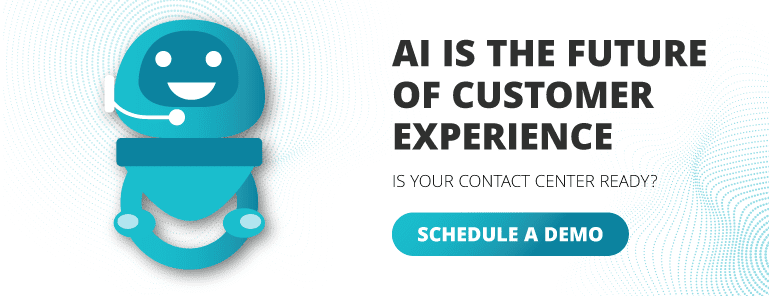You know when you’re frustrated on a call with a customer service agent and it’s clear that they’re just as frustrated as you? Yeah, it’s uncomfortable for everyone. But, when you connect with a rep who seems calm, competent, and—dare I say—enjoys their job, your experience as a customer changes entirely. That’s the power of a great service environment, where best practices support both customers and agents.
With that in mind, let’s dive into 13 customer service best practices you can start implementing today. These aren’t pie-in-the-sky ideas, either—they’re practical steps you can take now to make both your customers and agents smile.
13 Customer Service Best Practices to Show Your Customers and Agents Some Love
There’s no magical customer service formula, but these 13 customer service best practices are a great place to start. We’re talking about everything from empowering your agents to creating a seamless tech experience for your customers. Here’s how to get both sides to feel the love.
4 Customer Service Best Practices: Use Customer-Focused Tech
Let’s be honest: if your contact center isn’t embracing tech, you’re already behind. And I don’t mean just any tech. I’m talking about tools that put customers first while making agents’ lives easier. It’s a win-win situation, and here’s how to get there.
1. Add Omnichannel Support
Imagine this: Your customer sends an email on Monday, follows up on Instagram on Tuesday, and calls in on Wednesday—all without having to repeat themselves. That’s omnichannel support. By centralizing channels like email, social, chat, and phone into a single platform, you create a seamless experience.
Why it works: Customers get to choose the way they interact with you, and they don’t have to start over each time they switch channels. This leads to faster resolutions, better satisfaction, and increased loyalty. Customers feel heard—and that’s the goal.
2. Use AI for Predictive Customer Insights
AI isn’t just a host of fancy algorithms. It helps your team solve problems before they even come up. With the right AI customer experience, you can spot patterns, anticipate customer needs, and alert you to potential issues before your customers even pick up the phone.
Why it works: If you’re solving problems proactively, you’re not only saving time but also reducing the number of complaints. Customers love when companies know what they need before they ask. And, hey, fewer complaints mean fewer fires for your agents to put out, which makes their day a lot smoother.
3. Use Chatbots and IVR for Fast Responses
Repetitive queries are an agent’s worst nightmare—enter chatbots and IVR systems. Automate those routine questions, like “What’s my order status?” and let your human agents handle the more complex stuff.
Why it works: Fast responses make customers happy. Period. Meanwhile, agents get to focus on the more interesting problems, which increases their job satisfaction.
See how to add AI into your IVR using Broadvoice AI.
4. Offer Self-Service
A well-designed self-service portal is the Swiss Army knife of customer service. Customers can solve their problems at any hour by hitting up the FAQs, video guides, or troubleshooting steps.
Why it works: It’s simple: customers want (and like) to solve their own problems—without waiting for a human. Meanwhile, agents get fewer basic questions, letting them focus on tougher issues. Efficiency all around.
4 More Customer Service Best Practices: Empower Agents for Success
Happy agents are productive agents, and productivity leads to happy customers. So, how do you get your team there? Empowerment. Give them the tools, knowledge, and freedom to shine.
5. Train Agents on Empathy and Emotional Intelligence
Agents need more than just product knowledge. They need to understand how to connect with customers on a human level. Build empathy training into your onboarding and regular coaching sessions. Teach agents to read emotional cues, mirror customer language, and respond with compassion.
Why it works: When agents show empathy, it creates trust and rapport. Customers feel valued, not just as problems to be solved but as people to be understood. Trust me, it’s the secret sauce to boosting customer loyalty.
6. Create a Knowledge Base
A searchable knowledge base is every agent’s best friend. Think of it as their “cheat sheet,” filled with everything from product specs to troubleshooting tips. And if you add AI-powered features like Agent Assist, it gets even better—offering real-time suggestions during customer interactions.
Why it works: The faster your agents can find the right answers, the quicker they can resolve issues. This reduces resolution time, improves first contact resolution (FCR), and leads to happier customers. Plus, your agents will feel more confident and capable.
7. Add Flexible Solutions: Encourage Agent Autonomy
No one likes to be micromanaged. And that includes your agents. So, give them the autonomy to resolve routine escalations without running every decision up the chain of command.
Why it works: When agents are empowered to make decisions, they feel more confident and engaged. This not only reduces customer wait times but also improves agent morale. Win-win.
8. Keep Coaching and Training
Training shouldn’t end after the first few weeks. Continuous coaching is where the magic happens. Ongoing sessions that focus on product knowledge, customer service skills, and problem-solving keep your agents sharp.
Why it works: When agents are continuously learning, they’re engaged and feel valued. This, in turn, makes them more effective and improves the overall customer experience.
More Customer Service Best Practices: Improve Operational Efficiency
To keep things running smoothly, you need to take a good look at your operational efficiency. This doesn’t just help your agents; it directly impacts the quality of service your customers receive.
9. Use AI-Backed Workforce Management for Forecasting and Scheduling
Use AI-powered workforce management (WFM) to forecast demand, optimize staffing, and predict scheduling needs. The result? You’ll have the right number of agents available at the right time.
Why it works: WFM prevents long customer wait times by ensuring you have enough staff, while also reducing agent idle time. Less burnout, less stress, more productivity.
10. Add Proactive Support with Post-Interaction Follow-Up
Don’t let the conversation end when the issue is “solved.” Set up automated surveys or personalized email follow-ups after each interaction. Use AI to analyze responses and uncover new insights.
Why it works: Follow-ups show customers that you care about the entire journey, not just the problem at hand. It also provides valuable feedback to improve your service over time.
11. Connect Your CRM for More Personalized Interactions
Your customers expect personalization in every single interaction they have with a brand. Think about it, Netflix has spent years predicting what you’ll binge next, Spotify is discovering new music that you’ll thumbs up in seconds. So how are you adding personalization into your workflow? Start by integrating your CRM with your contact center tools. This gives agents access to detailed customer histories, preferences, and past interactions, helping them deliver totally tailored service.
Why it works: Personalized interactions foster better customer relationships. They lead to quicker resolutions and higher satisfaction because customers feel like you get them.
The Last Couple Best Practices: Performance Monitoring and Improvement
No contact center can be great without regular performance checks and improvements. Here’s how to keep leveling up.
12. Add QA Programs
Quality assurance (QA) isn’t meant to only point out mistakes. It should provide actionable feedback to help agents grow. Use AI-driven QA to analyze interactions in real-time and pinpoint specific areas for improvement.
Why it works: By regularly reviewing interactions and offering feedback, you can fine-tune agent performance and improve overall service quality.
13. Build a Positive Company Culture
Creating a great customer service environment starts with company culture. Just ask Zappos. They built a fun, engaging work culture where agents love coming to work, and it’s reflected in every customer interaction.
Why it works: A positive culture boosts agent satisfaction, and satisfied agents provide better service. It’s that simple.
At the end of the day, the best customer service focuses on the happiness of both your customers and your agents. Start small—implement a few of these tips now and make a plan to add more over time. Your customers and agents will thank you.













